Preparation and Application of Edible Chitosan Coating Incorporating Natamycin
Abstract
1. Introduction
2. Materials and Methods
2.1. Materials
2.2. Preparation of Coatings
2.3. Characterization of Coatings
2.3.1. Preservation Effect
2.3.2. Coating Solution Viscosity
2.4. Preparation of Composite Film
2.5. Characterization of Composite Film
2.5.1. Thickness and Transparency
2.5.2. Water Vapor Transmittance
2.5.3. Mechanical Properties
2.5.4. Microstructure
2.5.5. Antibacterial Properties
- (1)
- Zone of Inhibition
- (2)
- Dynamic changes in colony growth
2.6. Cherry Tomatoes Preservation Experiment
2.6.1. TSS Content
2.6.2. Vc Content
2.6.3. MDA Content
2.6.4. POD Activity
2.7. Statistical Analysis
3. Results and Discussion
3.1. Characterization of Coatings
3.1.1. Preservation Effect
3.1.2. Dynamic Viscosity of Coating
3.2. Characterization of Composite Film
3.2.1. Thickness and Transparency
3.2.2. Water Vapor Transmittance
3.2.3. Mechanical Properties
3.2.4. Microstructure
3.2.5. Antibacterial Properties
3.3. Cherry Tomato Preservation Results
3.3.1. Weight Loss Rate
3.3.2. Hardness Loss Rate
3.3.3. TSS Content
3.3.4. Vc Content
3.3.5. MDA Content
3.3.6. POD Activity
3.3.7. Preservation Effect
4. Conclusions
Author Contributions
Funding
Institutional Review Board Statement
Data Availability Statement
Conflicts of Interest
Abbreviations
| CTS | chitosan |
| WVT | water vapor transmittance |
| TS | tensile strength |
| EB | Elongation at break |
| TSS | total soluble solid |
| Vc | vitamin C |
| MDA | malondialdehyde |
| POD | peroxidase |
References
- Plastics Europe. Plastics—The Fast Facts 2023. Available online: https://plasticseurope.org/knowledge-hub/plastics-the-fast-facts-2023/ (accessed on 1 February 2025).
- Han, H.-S.; Song, K.B. Antioxidant properties of watermelon (Citrullus lanatus) rind pectin films containing kiwifruit (Actinidia chinensis) peel extract and their application as chicken thigh packaging. Food Packag. Shelf Life 2021, 28, 100636. [Google Scholar] [CrossRef]
- Ye, X.; Liu, R.; Qi, X.; Wang, X.; Wang, Y.; Chen, Q.; Gao, X. Preparation of bioactive gelatin film using semi-refined pectin reclaimed from blueberry juice pomace: Creating an oxidation and light barrier for food packaging. Food Hydrocoll. 2022, 129, 107673. [Google Scholar] [CrossRef]
- Liu, J.; Song, F.; Chen, R.; Deng, G.; Chao, Y.; Yang, Z.; Wu, H.; Bai, M.; Zhang, P.; Hu, Y. Effect of cellulose nanocrystal-stabilized cinnamon essential oil Pickering emulsions on structure and properties of chitosan composite films. Carbohydr. Polym. 2022, 275, 118704. [Google Scholar] [CrossRef]
- Aaliya, B.; Sunooj, K.V.; Ashina, S.; Priyanka, K.; Navaf, M.; Akhila, P.P.; Raviteja, P.; Sinha, S.K.; Yadav, V.; Mir, S.A.; et al. Synthesis, characterization, and in-vivo application of non-thermal plasma-modified talipot starch-Aloe vera gel biocomposite films for enhancing the shelf life of guava fruits. Food Packag. Shelf Life 2023, 40, 10. [Google Scholar] [CrossRef]
- Faraj, A.M.; Nouri, M. Development of a mucilage coating including nanoencapsulated essential oils for extending shelf life of button mushrooms (Agaricus bisporus). Food Packag. Shelf Life 2024, 41, 10. [Google Scholar] [CrossRef]
- Kumar, N.; Neeraj; Pratibha; Trajkovska Petkoska, A. Improved Shelf Life and Quality of Tomato (Solanum lycopersicum L.) by Using Chitosan-Pullulan Composite Edible Coating Enriched with Pomegranate Peel Extract. ACS Food Sci. Technol. 2021, 1, 500–510. [Google Scholar] [CrossRef]
- Pinzon, M.I.; Sanchez, L.T.; Garcia, O.R.; Gutierrez, R.; Luna, J.C.; Villa, C.C. Increasing shelf life of strawberries (Fragaria ssp.) by using a banana starch-chitosan-Aloe vera gel composite edible coating. Int. J. Food Sci. Technol. 2019, 55, 92–98. [Google Scholar] [CrossRef]
- Anjum, M.A.; Akram, H.; Zaidi, M.; Ali, S. Effect of gum arabic and Aloe vera gel based edible coatings in combination with plant extracts on postharvest quality and storability of ‘Gola’ guava fruits. Sci. Hortic. 2020, 271, 109506. [Google Scholar] [CrossRef]
- Ahouagi, V.B.; Mequelino, D.B.; Tavano, O.L.; Garcia, J.A.D.; Nachtigall, A.M.; Vilas Boas, B.M. Physicochemical characteristics, antioxidant activity, and acceptability of strawberry-enriched ketchup sauces. Food Chem. 2020, 340, 127925. [Google Scholar] [CrossRef]
- Chen, C.; Peng, X.; Chen, J.; Gan, Z.; Wan, C. Mitigating effects of chitosan coating on postharvest senescence and energy depletion of harvested pummelo fruit response to granulation stress. Food Chem. 2021, 348, 129113. [Google Scholar] [CrossRef]
- Bagheri, R.; Ariaii, P.; Motamedzadegan, A. Characterization, antioxidant and antibacterial activities of chitosan nanoparticles loaded with nettle essential oil. J. Food Meas. Charact. 2020, 15, 1395–1402. [Google Scholar] [CrossRef]
- da Costa de Quadros, C.; Lima, K.O.; Bueno, C.H.L.; dos Santos Fogaça, F.H.; Rocha, M.; Prentice, C. Effect of the edible coating with protein hydrolysate on cherry tomatoes shelf life. J. Food Process. Preserv. 2020, 44, e14760. [Google Scholar] [CrossRef]
- Sun, Y.; Lan, W.; Liu, S.; Guan, Y.; Zhu, S.; Xie, J. Preparation of chitosan grafted caffeic acid coating and its effect on pompano (Trachinotus ovatus) preservation. J. Sci. Food Agric. 2021, 102, 2835–2845. [Google Scholar] [CrossRef]
- Dong, Z.; Jiang, X.; Jiang, Z.; Lv, L.; He, M. Preparation of glycerol plasticized chitosan films using AlCl3·6H2O as the solvent: Optical, crystalline, mechanical and barrier properties. Int. J. Polym. Anal. Charact. 2019, 24, 295–303. [Google Scholar] [CrossRef]
- Liu, H.; Zhao, H.; Lyu, L.; Huang, Z.; Fan, S.; Wu, W.; Li, W. Synergistic effect of natural antifungal agents for postharvest diseases of blackberry fruits. J. Sci. Food Agric. 2019, 99, 3343–3349. [Google Scholar] [CrossRef]
- Yuan, Y.; Wang, H.; Fu, Y.; Chang, C.; Wu, J. Sodium alginate/gum arabic/glycerol multicomponent edible films loaded with natamycin: Study on physicochemical, antibacterial, and sweet potatoes preservation properties. Int. J. Biol. Macromol. 2022, 213, 1068–1077. [Google Scholar] [CrossRef] [PubMed]
- Wang, X.H.; Song, X.J.; Zhang, D.J.; Li, Z.J.; Wang, H.J. Preparation and characterization of natamycin-incorporated agar film and its application on preservation of strawberries. Food Packag. Shelf Life 2022, 32, 100863. [Google Scholar] [CrossRef]
- Shen, C.Y.; Rao, J.S.; Wu, D.; Chen, K.S. Multifunctional fibrous films fabricated by microfluidic blow spinning for the preservation of fresh-cut apples. Postharvest Biol. Technol. 2024, 211, 10. [Google Scholar] [CrossRef]
- Kumar, N.; Kaur, P.; Devgan, K.; Attkan, A.K. Shelf life prolongation of cherry tomato using magnesium hydroxide reinforced bio-nanocomposite and conventional plastic films. J. Food Process. Preserv. 2020, 44, e14379. [Google Scholar] [CrossRef]
- Wigati, L.P.; Wardana, A.A.; Tanaka, F.; Tanaka, F. Strawberry preservation using combination of yam bean starch, agarwood Aetoxylon bouya essential oil, and calcium propionate edible coating during cold storage evaluated by TOPSIS-Shannon entropy. Prog. Org. Coat. 2023, 175, 13. [Google Scholar] [CrossRef]
- Li, Y.; Zhou, Y.; Wang, Z.; Cai, R.; Yue, T.; Cui, L. Preparation and Characterization of Chitosan–Nano-ZnO Composite Films for Preservation of Cherry Tomatoes. Foods 2021, 10, 3135. [Google Scholar] [CrossRef] [PubMed]
- Li, Y.; Zheng, L.; Mustafa, G.; Shao, Z.; Liu, H.; Li, Y.; Wang, Y.; Liu, L.; Xu, C.; Wang, T.; et al. Enhancing post-harvest quality of tomato fruits with chitosan oligosaccharide-zinc oxide nanocomposites: A study on biocompatibility, quality improvement, and carotenoid enhancement. Food Chem. 2024, 454, 139685. [Google Scholar] [CrossRef] [PubMed]
- GB/T 1037-2021; Test Method for Water Vapor Transmission of Plastic Film and Sheet—Desiccant Method and Water Method. Standards Press of China: Beijing, China, 2021.
- ASTME96-2014; Standard Test Methods for Water Vapor Transmission of Materials. ASTM International: West Conshohocken, PA, USA, 2014.
- GB/T 1040.3-2006; Plastics—Determination of Tensile Properties—Part 3: Test Conditions for Films and Sheets. Standards Press of China: Beijing, China, 2006.
- Khafid, A.; Nurchayati, Y.; Hastuti, E.D.; Setiari, N. Vitamin C and total soluble solid content of crystal guava at different storage duration and ripeness. Kultivasi 2023, 22, 147–156. [Google Scholar] [CrossRef]
- Liu, F.; Yang, N.; Zhang, L.T.; Cui, B.; Jin, Y.M.; Jin, Z.Y.; Xu, X.M. Magnetic field delays the senescence of strawberries by maintaining energy state and regulating respiratory metabolism. Postharvest Biol. Technol. 2023, 199, 12. [Google Scholar] [CrossRef]
- Liu, W.Q.; Huang, K.Y.; Tan, Z.M.; Wang, C.S.; Wen, T.Q.; Huang, L.Y.; Hang, F.X.; Xie, C.F.; Wang, S.P.; Li, K. Application of nisin-embedded pectin microcapsules for ‘Guiqi’ mango fruit postharvest preservation. Food Packag. Shelf Life 2024, 42, 13. [Google Scholar] [CrossRef]
- Zhang, M.H.; Chen, H.Y. Development and characterization of starch-sodium alginate-montmorillonite biodegradable antibacterial films. Int. J. Biol. Macromol. 2023, 233, 10. [Google Scholar] [CrossRef]
- Fozia, R.; Insha, Z.; Wani Suhana, A.; Tariq Ahmad, G.; Aamir Hussain, D.; Salma Zainab, F.; Tanveer Ahmad, M. Formulation and characterization of natural almond gum as an edible coating source for enhancing the shelf life of fresh cut pineapple slices. Food Chem. Adv. 2023, 3, 100366. [Google Scholar] [CrossRef]
- Xu, J.H.; Wei, R.B.; Jia, Z.; Song, R. Characteristics and bioactive functions of chitosan/gelatin-based film incorporated with ε-polylysine and astaxanthin extracts derived from by-products of shrimp (Litopenaeus vannamei). Food Hydrocoll. 2020, 100, 13. [Google Scholar] [CrossRef]
- Pavinatto, A.; de Almeida Mattos, A.V.; Malpass, A.C.G.; Okura, M.H.; Balogh, D.T.; Sanfelice, R.C. Coating with chitosan-based edible films for mechanical/biological protection of strawberries. Int. J. Biol. Macromol. 2020, 151, 1004–1011. [Google Scholar] [CrossRef]
- Lin, M.H.; Fang, S.; Zhao, X.J.; Liang, X.R.; Wu, D. Natamycin-loaded zein nanoparticles stabilized by carboxymethyl chitosan: Evaluation of colloidal/chemical performance and application in postharvest treatments. Food Hydrocoll. 2020, 106, 10. [Google Scholar] [CrossRef]
- Du, Y.; Li, Y.; Tian, Z.; Cheng, Y.; Long, C.A. Natamycin as a safe food additive to control postharvest green mould and sour rot in citrus. J. Appl. Microbiol. 2022, 133, 3438–3450. [Google Scholar] [CrossRef] [PubMed]
- Xu, X.; Peng, X.; Huan, C.; Chen, J.; Meng, Y.; Fang, S. Development of natamycin-loaded zein-casein composite nanoparticles by a pH-driven method and application to postharvest fungal control on peach against Monilinia fructicola. Food Chem. 2023, 404, 134659. [Google Scholar] [CrossRef]
- Van, T.T.; Phuong, N.T.H.; Sakamoto, K.; Wigati, L.P.; Tanaka, F.; Tanaka, F. Effect of edible coating incorporating sodium carboxymethyl cellulose/cellulose nanofibers and self-produced mandarin oil on strawberries. Food Packag. Shelf Life 2023, 40, 11. [Google Scholar] [CrossRef]
- Aranaz, I.; Alcántara, A.R.; Civera, M.C.; Arias, C.; Elorza, B.; Heras Caballero, A.; Acosta, N. Chitosan: An Overview of Its Properties and Applications. Polymers 2021, 13, 3256. [Google Scholar] [CrossRef]
- Duan, Q.F.; Chen, Y.; Yu, L.; Xie, F.W. Chitosan–Gelatin Films: Plasticizers/Nanofillers Affect Chain Interactions and Material Properties in Different Ways. Polymers 2022, 14, 3797. [Google Scholar] [CrossRef] [PubMed]
- Chen, Y.Y.; Hu, Q.; Wang, Q.; Yu, M.H.; Gong, X.Y.; Li, S.J.; Xiao, J.; Guo, Y.J.; Chen, G.Y.; Lai, X.Y. Flexible translucent chitosan–glycerin/QD nanocomposite glue for anti-counterfeiting films with strong adhesion and stability. RSC Adv. 2020, 10, 23410–23416. [Google Scholar] [CrossRef]
- Dong, Y.T.; Li, Y.J.; Ma, Z.X.; Rao, Z.L.; Zheng, X.J.; Tang, K.Y.; Liu, J. Effect of polyol plasticizers on properties and microstructure of soluble soybean polysaccharide edible films. Food Packag. Shelf Life 2023, 35, 101023. [Google Scholar] [CrossRef]
- Sirisha Nallan Chakravartula, S.; Lourenço, R.V.; Balestra, F.; Quinta Barbosa Bittante, A.M.; Sobral, P.J.d.A.; Dalla Rosa, M. Influence of pitanga (Eugenia uniflora L.) leaf extract and/or natamycin on properties of cassava starch/chitosan active films. Food Packag. Shelf Life 2020, 24, 100498. [Google Scholar] [CrossRef]
- Seungjae, M.; Ruchir, P.; Parya, E.; Jong-Whan, R.; Jun Tae, K. Chitosan-based multifunctional coating combined with sulfur quantum dots to prevent Listeria contamination of enoki mushrooms. Food Packag. Shelf Life 2023, 35, 101014. [Google Scholar] [CrossRef]
- Yanyi, W.; Jia, L.; Lei, J.; Zhongjie, Z.; Suirui, H.; Shu, H.; Wei, S. Development of intelligent/active food packaging film based on TEMPO-oxidized bacterial cellulose containing thymol and anthocyanin-rich purple potato extract for shelf life extension of shrimp. Food Packag. Shelf Life 2021, 29, 100709. [Google Scholar] [CrossRef]
- Guo, H.L.; Xu, Y.; Chen, H.Y.; Si, X.Y.; Zhou, M.H.; Zhu, E.L. Antagonistic yeast and trehalose-enriched gelatin film: A bioactive antifungal packaging film for cherry tomato preservation. Food Packag. Shelf Life 2024, 42, 10. [Google Scholar] [CrossRef]
- Chang, C.; Lin, F.; Tsai, S.; Gavahian, M.; Cheng, K.; Hou, C.; Chen, M.; Santoso, S.; Hsieh, C. Active packaging incorporating chitosan, casein phosphopeptide, and plasmonic modification to maintain quality and regulate the respiration rate of fresh-cut Pyrus serotina Rehder during storage. Food Packag. Shelf Life 2023, 40, 101223. [Google Scholar] [CrossRef]
- Jha, P. Effect of plasticizer and antimicrobial agents on functional properties of bionanocomposite films based on corn starch-chitosan for food packaging applications. Int. J. Biol. Macromol. 2020, 160, 571–582. [Google Scholar] [CrossRef]
- Salama, H.E.; Abdel Aziz, M.S. Optimized alginate and Aloe vera gel edible coating reinforced with nTiO2 for the shelf-life extension of tomatoes. Int. J. Biol. Macromol. 2020, 165, 2693–2701. [Google Scholar] [CrossRef]
- Moreno, M.A.; Bojorges, H.; Falcó, I.; Sánchez, G.; López-Carballo, G.; López-Rubio, A.; Zampini, I.C.; Isla, M.I.; Fabra, M.J. Active properties of edible marine polysaccharide-based coatings containing Larrea nitida polyphenols enriched extract. Food Hydrocoll. 2020, 102, 105595. [Google Scholar] [CrossRef]
- Srinivasa, P.C.; Ramesh, M.N.; Tharanathan, R.N. Effect of plasticizers and fatty acids on mechanical and permeability characteristics of chitosan films. Food Hydrocoll. 2007, 21, 1113–1122. [Google Scholar] [CrossRef]
- do Vale, D.A.; Vieira, C.B.; de Oliveria, J.M.; Vidal, M.F.; de Alcântara, L.O.; da Silva, A.I.M.; de Lima Silva, J.M.; Andrade, F.K.; Sousa, J.R.; Moreira Souza Filho, M.d.S.; et al. Determining the wetting capacity of the chitosan coatings from Ucides cordatus and evaluating the shelf-life quality of Scomberomorus brasiliensis fillets. Food Control 2020, 116, 107329. [Google Scholar] [CrossRef]
- Meena, M.; Prajapati, P.; Ravichandran, C.; Sehrawat, R. Natamycin: A natural preservative for food applications—A review. Food Sci. Biotechnol. 2021, 30, 1481–1496. [Google Scholar] [CrossRef]
- Xiaohan, G.; Xueying, H.; Liping, Z.; Yi, W. Essential oil-loaded antimicrobial and antioxidant zein/poly(lactic acid) film as active food packaging. Food Packag. Shelf Life 2022, 34, 100977. [Google Scholar] [CrossRef]
- Chaudhary, S.; Kumar, S.; Kumar, V.; Sharma, R. Chitosan nanoemulsions as advanced edible coatings for fruits and vegetables: Composition, fabrication and developments in last decade. Int. J. Biol. Macromol. 2020, 152, 154–170. [Google Scholar] [CrossRef]
- Liang, W.; Ge, X.Z.; Lin, Q.; Niu, L.; Zhao, W.Q.; Liu, X.Y.; Guo, S.F.; Muratkhan, M.; Li, W.H. pH-responsive PVA/konjac glucomannan/functional liposome terpolymer composites: Spotlight on its structure-performance, functionality, barrier properties, controlled-release behavior, biodegradability, and its intelligent preservation role for food. Food Packag. Shelf Life 2024, 42, 14. [Google Scholar] [CrossRef]
- Jha, P. Effect of grapefruit seed extract ratios on functional properties of corn starch-chitosan bionanocomposite films for active packaging. Int. J. Biol. Macromol. 2020, 163, 1546–1556. [Google Scholar] [CrossRef] [PubMed]
- Zhang, D.W.; Yang, S.A.; Zhang, K.K.; Zhou, G.L.; Jiang, Z.X.; Gu, J.Y. Shape memory effect of chitosan/glycerol composite film in mixed water/ethanol solution. J. Appl. Polym. Sci. 2018, 136, 47037. [Google Scholar] [CrossRef]
- Yi, M.; Zhao, H.Q.; Ma, Q.Y.; Cheng, D.W.; Zhang, Y.F.; Wang, W.X.; Wang, J.; Sun, J.F. Development of chitosan/potato peel polyphenols nanoparticles driven extended-release antioxidant films based on potato starch. Food Packag. Shelf Life 2022, 31, 100793. [Google Scholar] [CrossRef]
- Basumatary, I.B.; Mukherjee, A.; Katiyar, V.; Kumar, S. Biopolymer-based nanocomposite films and coatings: Recent advances in shelf-life improvement of fruits and vegetables. Crit. Rev. Food Sci. Nutr. 2020, 62, 1912–1935. [Google Scholar] [CrossRef]
- Das, S.K.; Vishakha, K.; Das, S.; Ganguli, A. Antibacterial and antibiofilm activities of nanoemulsion coating prepared by using caraway oil and chitosan prolongs the shelf life and quality of bananas. Appl. Food Res. 2023, 3, 100300. [Google Scholar] [CrossRef]
- Popescu, P.-A.; Palade, L.M.; Nicolae, I.-C.; Popa, E.E.; Miteluț, A.C.; Drăghici, M.C.; Matei, F.; Popa, M.E. Chitosan-Based Edible Coatings Containing Essential Oils to Preserve the Shelf Life and Postharvest Quality Parameters of Organic Strawberries and Apples during Cold Storage. Foods 2022, 11, 3317. [Google Scholar] [CrossRef]
- Lee, S.J.; Gwak, M.A.; Chathuranga, K.; Lee, J.S.; Koo, J.; Park, W.H. Multifunctional chitosan/tannic acid composite films with improved anti-UV, antioxidant, and antimicrobial properties for active food packaging. Food Hydrocoll. 2023, 136, 108249. [Google Scholar] [CrossRef]
- Naderi Bab Anari, H.; Majdinasab, M.; Shaghaghian, S.; Khalesi, M. Development of a natamycin-based non-migratory antimicrobial active packaging for extending shelf-life of yogurt drink (Doogh). Food Chem. 2022, 366, 130606. [Google Scholar] [CrossRef]
- Yang, Y.; Huan, C.; Liang, X.; Fang, S.; Wang, J.; Chen, J. Development of Starch-Based Antifungal Coatings by Incorporation of Natamycin/Methyl-?-Cyclodextrin Inclusion Complex for Postharvest Treatments on Cherry Tomato against Botrytis cinerea. Molecules 2019, 24, 3962. [Google Scholar] [CrossRef]
- Shahidi, F.; Hossain, A. Preservation of aquatic food using edible films and coatings containing essential oils: A review. Crit. Rev. Food Sci. Nutr. 2020, 62, 66–105. [Google Scholar] [CrossRef] [PubMed]
- Kang, S.; Xiao, Y.; Guo, X.; Huang, A.; Xu, H. Development of gum arabic-based nanocomposite films reinforced with cellulose nanocrystals for strawberry preservation. Food Chem. 2021, 350, 129199. [Google Scholar] [CrossRef] [PubMed]
- Yadav, A.; Kumar, N.; Upadhyay, A.; Sethi, S.; Singh, A. Edible coating as postharvest management strategy for shelf-life extension of fresh tomato (Solanum lycopersicum L.): An overview. J. Food Sci. 2022, 87, 2256–2290. [Google Scholar] [CrossRef] [PubMed]
- Quintana, S.E.; Llalla, O.; García-Risco, M.R.; Fornari, T. Comparison between essential oils and supercritical extracts into chitosan-based edible coatings on strawberry quality during cold storage. J. Supercrit. Fluids 2021, 171, 105198. [Google Scholar] [CrossRef]
- Priyadarshi, R.; Rhim, J.-W. Chitosan-based biodegradable functional films for food packaging applications. Innov. Food Sci. Emerg. Technol. 2020, 62, 102346. [Google Scholar] [CrossRef]
- Gangfeng, L.; Linjie, L.; Shaobiao, F.; Huan, W.; Miao, Z.; Ruilin, L.; Zhenzhen, L. Interaction between chitosan and natamycin maintain freshness quality and enzymatic activity of post-harvest Prunus salicina Lindl. cv. ‘Shazikongxinli’ fruit. Sustain. Chem. Pharm. 2022, 27, 100704. [Google Scholar] [CrossRef]
- Wu, Y.; Xu, F.; Zhao, H.; Wu, H.; Sun, C.; Li, Q. Furoic acid-mediated konjac glucomannan/flaxseed gum based green biodegradable antibacterial film for Shine-Muscat grape preservation. Int. J. Biol. Macromol. 2023, 253, 126883. [Google Scholar] [CrossRef]
- Sun, J.; Zhong, X.; Sun, D.; Cao, X.; Yao, F.; Shi, L.; Liu, Y. Structural characterization of polysaccharides recovered from extraction residue of ginseng root saponins and its fruit nutrition preservation performance. Front. Nutr. 2022, 9, 934927. [Google Scholar] [CrossRef]
- Zhang, C.; Yang, Z.; Shi, J.; Zou, X.; Zhai, X.; Huang, X.; Li, Z.; Holmes, M.; Daglia, M.; Xiao, J. Physical properties and bioactivities of chitosan/gelatin-based films loaded with tannic acid and its application on the preservation of fresh-cut apples. LWT 2021, 144, 111223. [Google Scholar] [CrossRef]
- Qianxi, Z.; Mijing, J.; Leyin, G.; Huahua, P.; Yuyu, N.; Jingping, R. Modified atmosphere packaging and 1-methylcyclopropene alleviate chilling injury of ‘Youhou’ sweet persimmon during cold storage. Food Packag. Shelf Life 2020, 24, 100479. [Google Scholar] [CrossRef]
- Saleem, M.S.; Anjum, M.A.; Naz, S.; Ali, S.; Hussain, S.; Azam, M.; Sardar, H.; Khaliq, G.; Canan, İ.; Ejaz, S. Incorporation of ascorbic acid in chitosan-based edible coating improves postharvest quality and storability of strawberry fruits. Int. J. Biol. Macromol. 2021, 189, 160–169. [Google Scholar] [CrossRef] [PubMed]
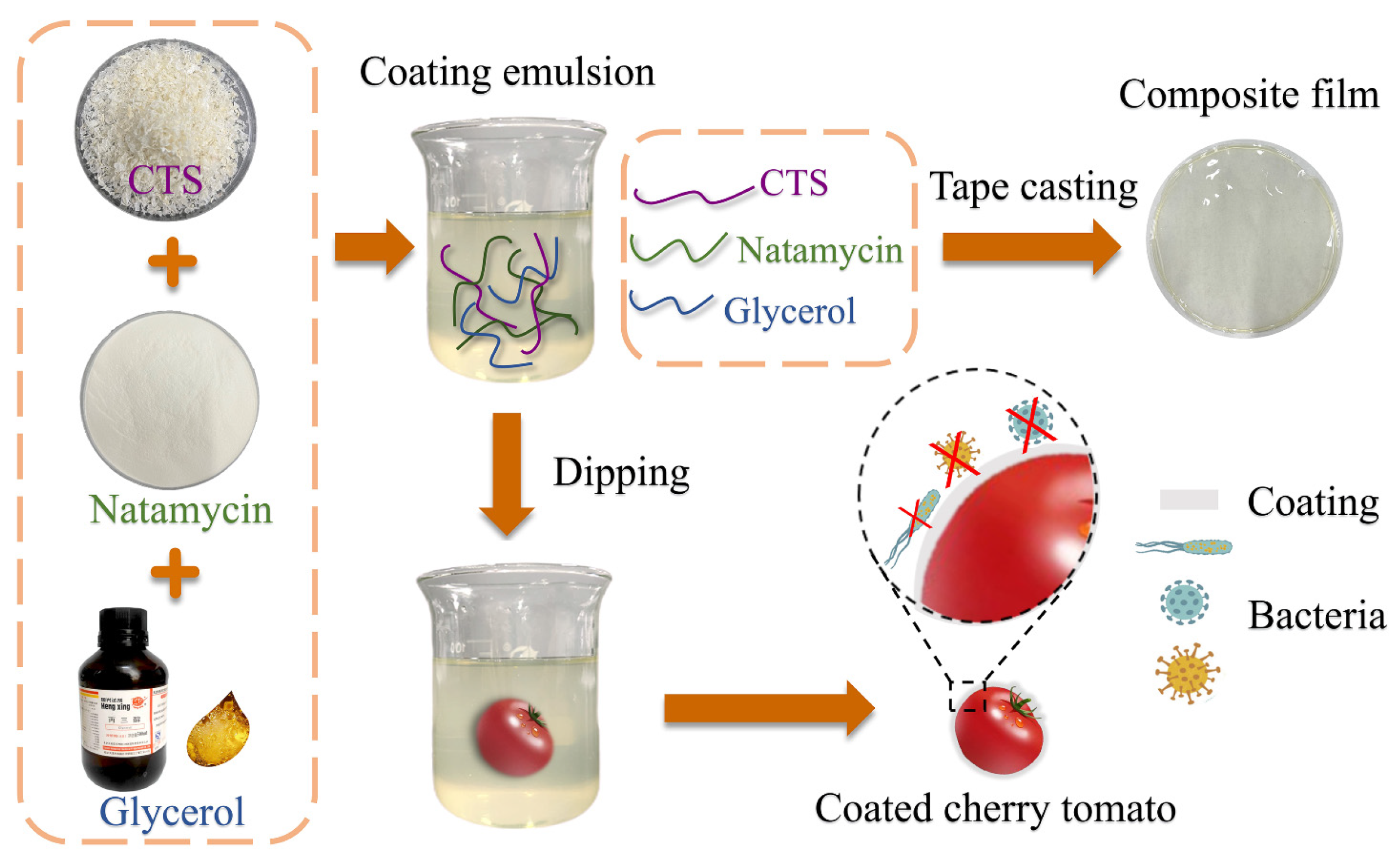
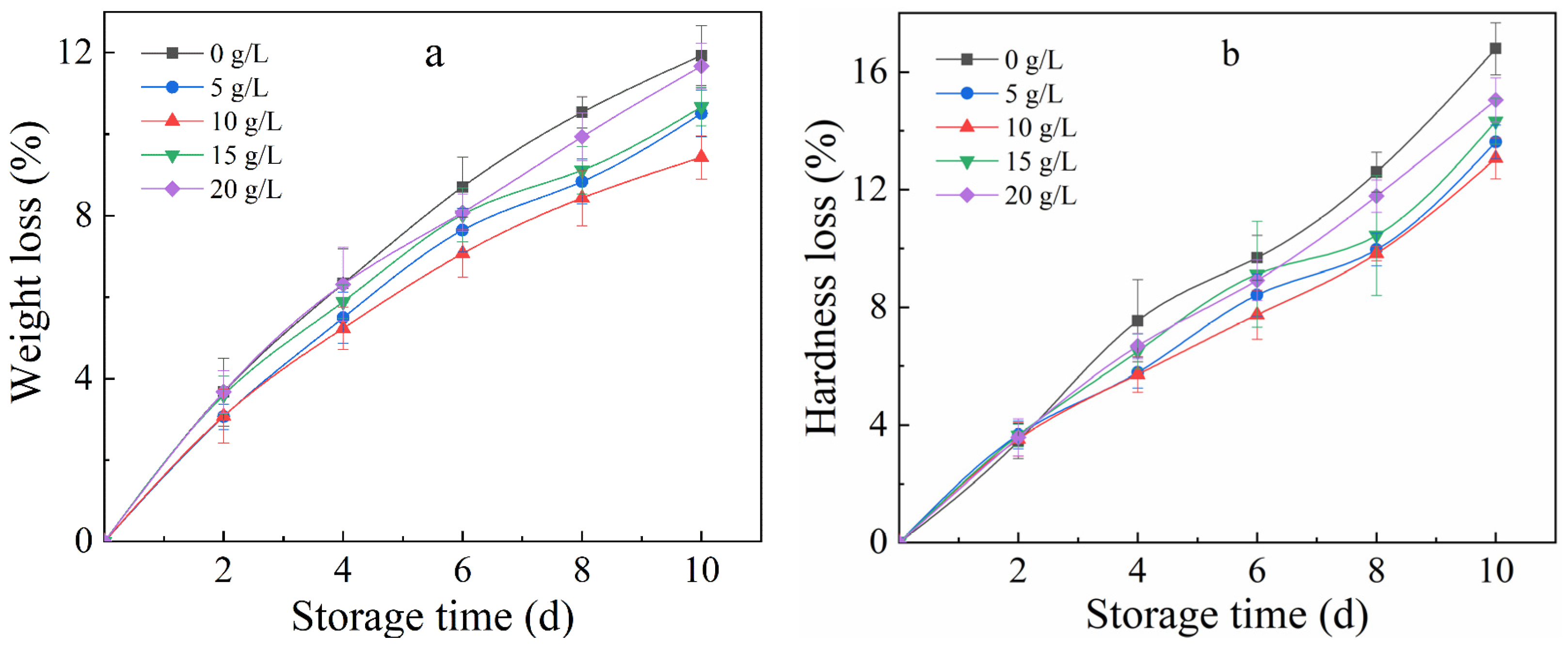
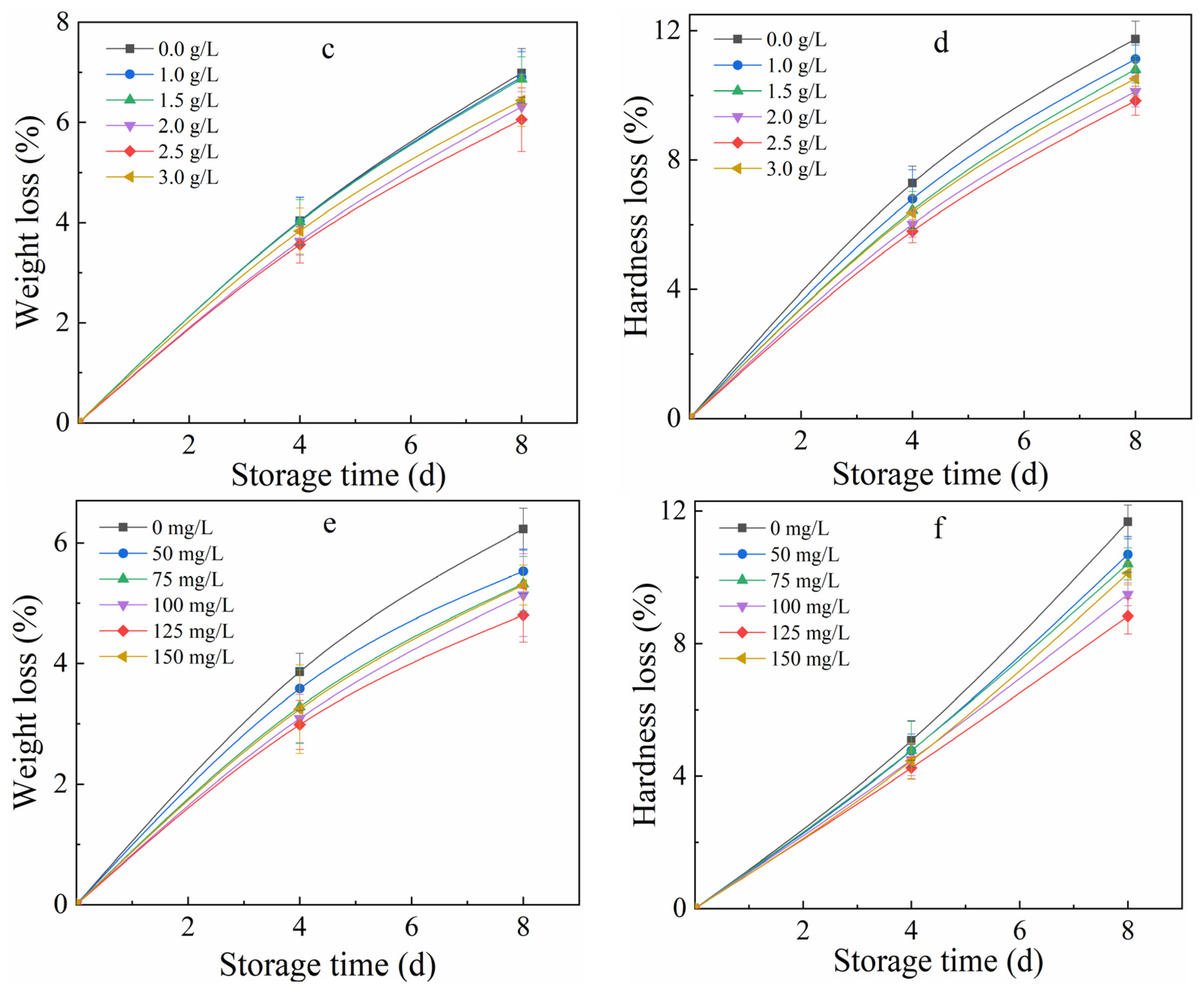

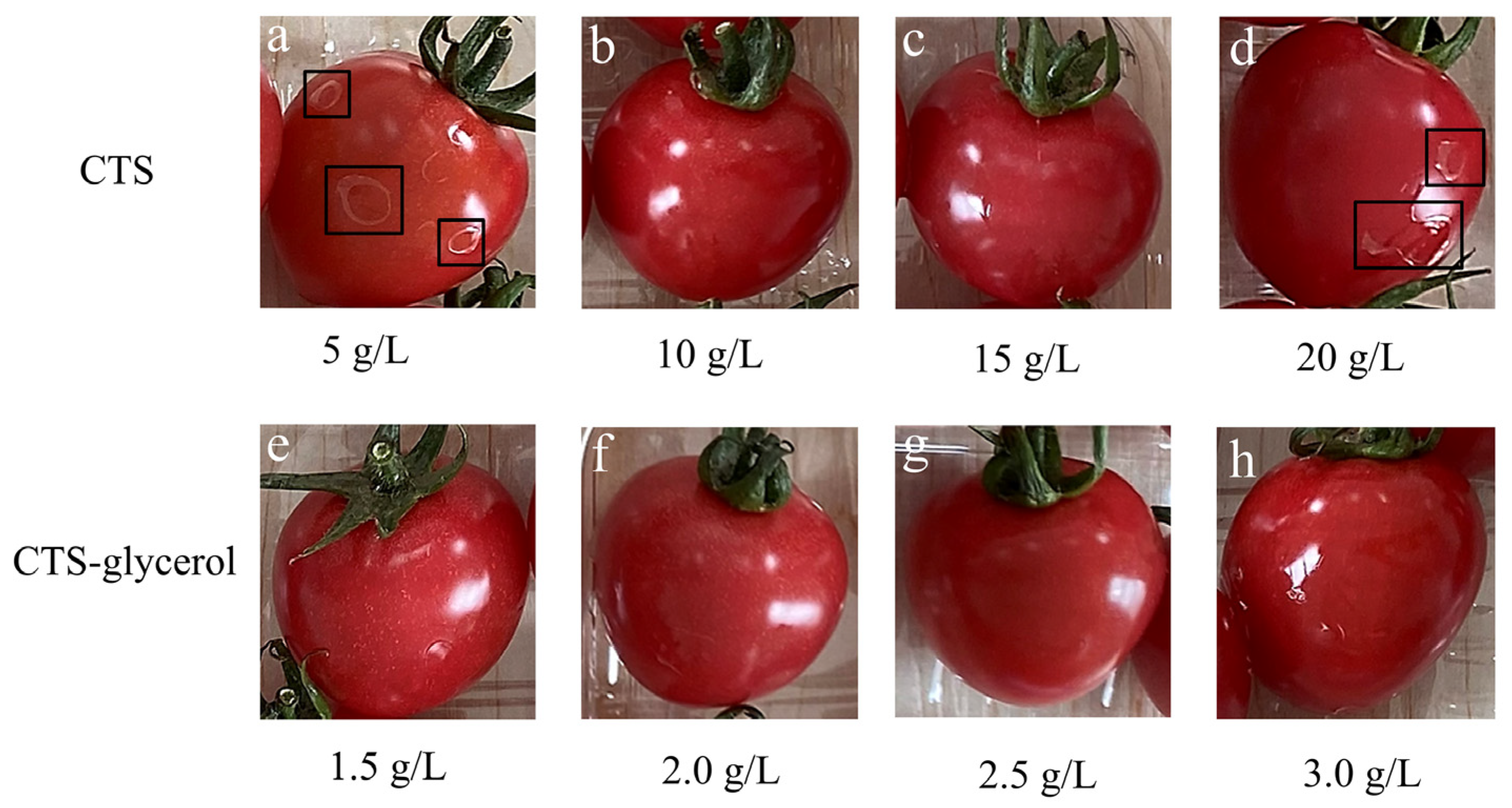



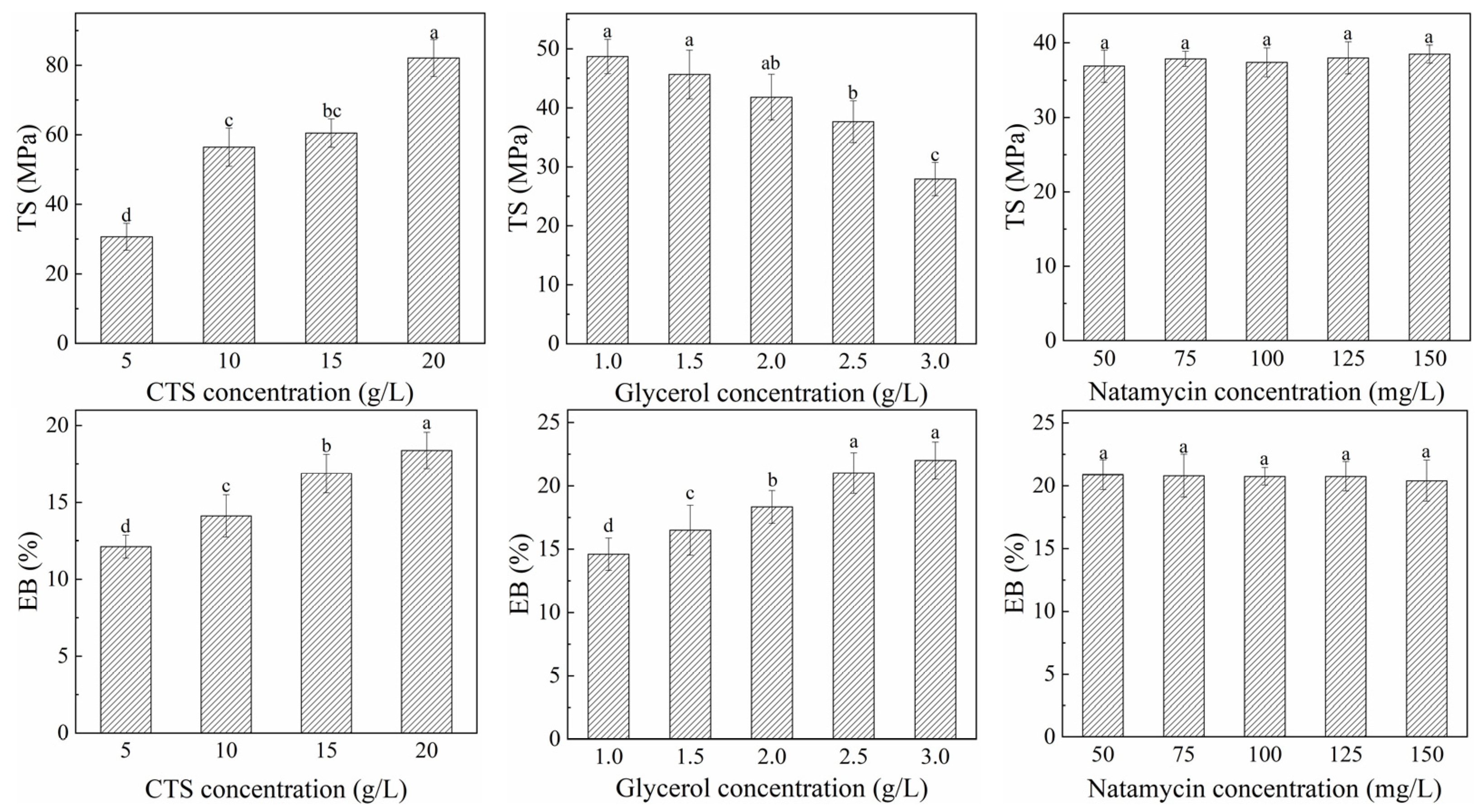
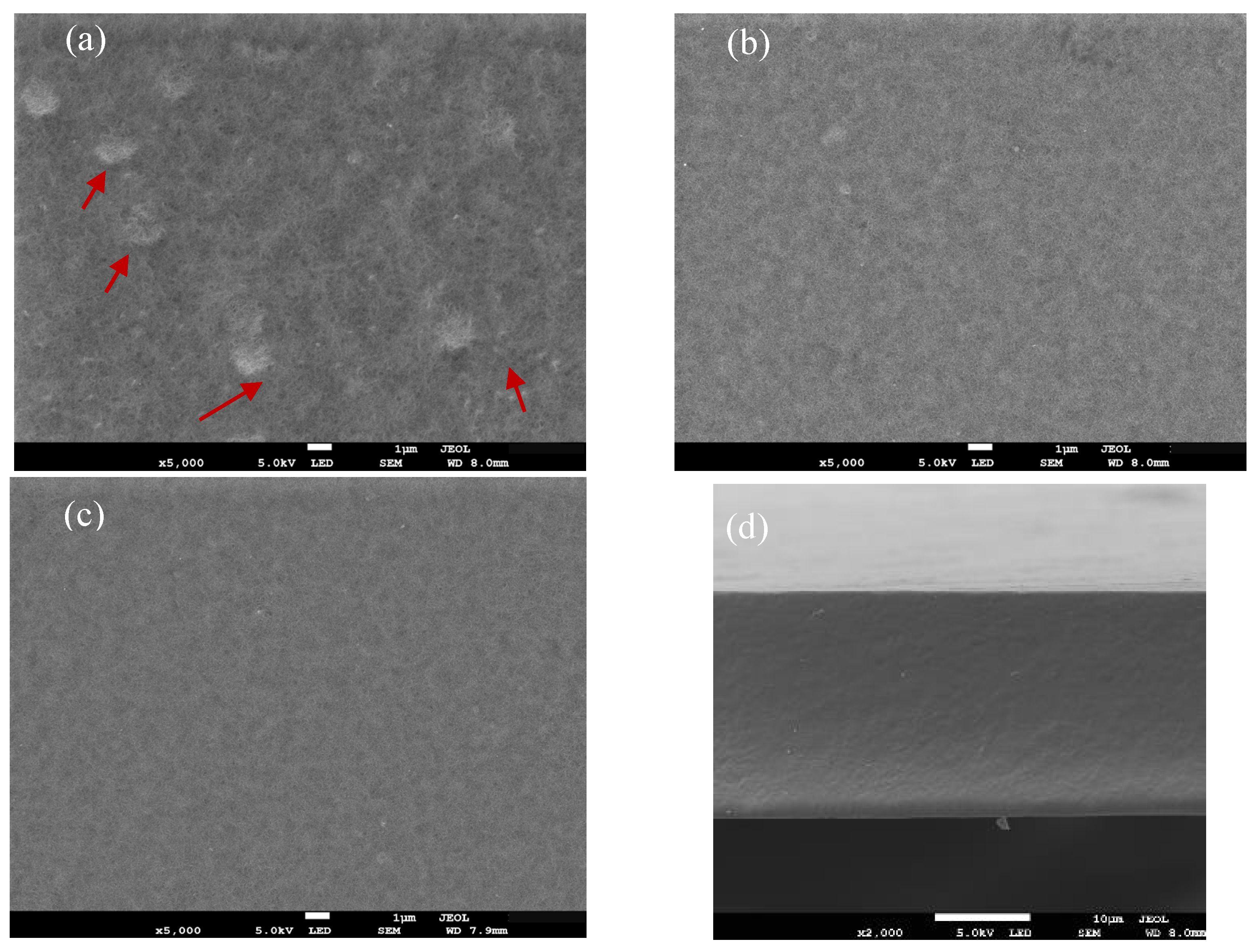
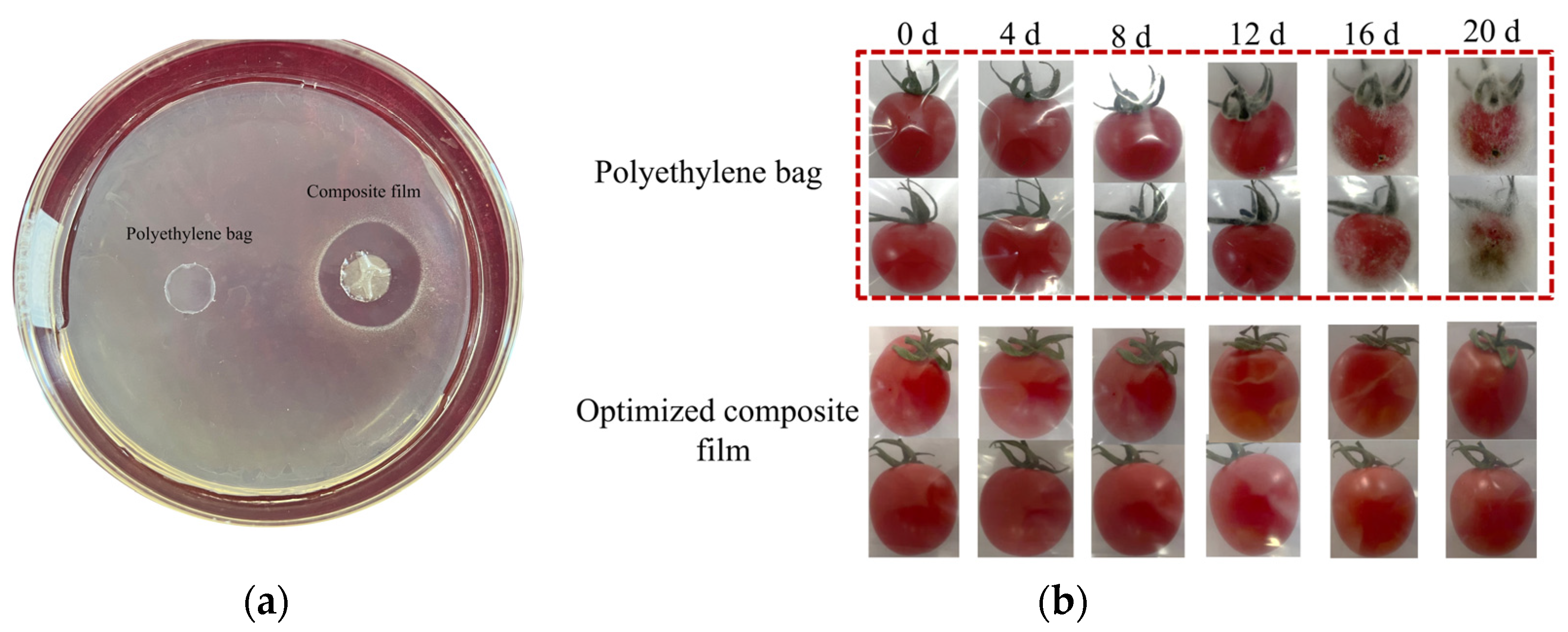
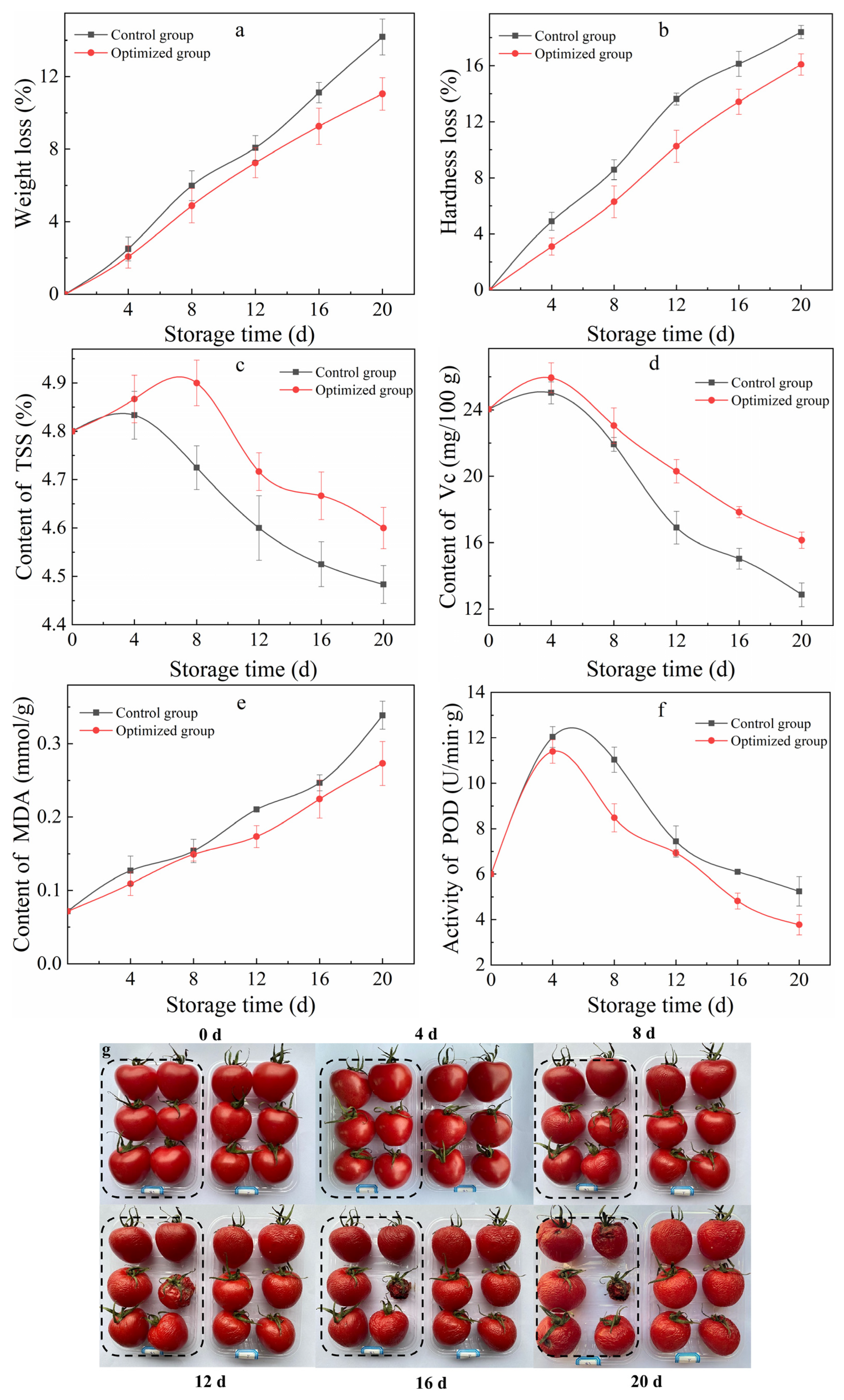
| Solute | Solvent | Experiment Group |
| CTS, 1% acetic acid | Distilled water | CTS concentrations of 0 g/L, 5 g/L, 10 g/L, 15 g/L, and 20 g/L |
| Glycerol | Optimized CTS coating solution | Glycerol concentrations of 0.0 g/L, 1.0 g/L, 1.5 g/L, 2.0 g/L, 2.5 g/L, and 3.0 g/L |
| Natamycin | Optimized CTS–glycerol composite coating solution | Natamycin concentrations of 0 mg/L, 50 mg/L, 75 mg/L, 100 mg/L, 125 mg/L, and 150 mg/L |
Disclaimer/Publisher’s Note: The statements, opinions and data contained in all publications are solely those of the individual author(s) and contributor(s) and not of MDPI and/or the editor(s). MDPI and/or the editor(s) disclaim responsibility for any injury to people or property resulting from any ideas, methods, instructions or products referred to in the content. |
© 2025 by the authors. Licensee MDPI, Basel, Switzerland. This article is an open access article distributed under the terms and conditions of the Creative Commons Attribution (CC BY) license (https://creativecommons.org/licenses/by/4.0/).
Share and Cite
Sun, J.; Wang, T.; Liu, L.; Li, Q.; Liu, H.; Wang, X.; Liu, M.; Zhang, H. Preparation and Application of Edible Chitosan Coating Incorporating Natamycin. Polymers 2025, 17, 1062. https://doi.org/10.3390/polym17081062
Sun J, Wang T, Liu L, Li Q, Liu H, Wang X, Liu M, Zhang H. Preparation and Application of Edible Chitosan Coating Incorporating Natamycin. Polymers. 2025; 17(8):1062. https://doi.org/10.3390/polym17081062
Chicago/Turabian StyleSun, Jianming, Tiantian Wang, Lei Liu, Qian Li, Hui Liu, Xiaofang Wang, Mengrui Liu, and Han Zhang. 2025. "Preparation and Application of Edible Chitosan Coating Incorporating Natamycin" Polymers 17, no. 8: 1062. https://doi.org/10.3390/polym17081062
APA StyleSun, J., Wang, T., Liu, L., Li, Q., Liu, H., Wang, X., Liu, M., & Zhang, H. (2025). Preparation and Application of Edible Chitosan Coating Incorporating Natamycin. Polymers, 17(8), 1062. https://doi.org/10.3390/polym17081062




